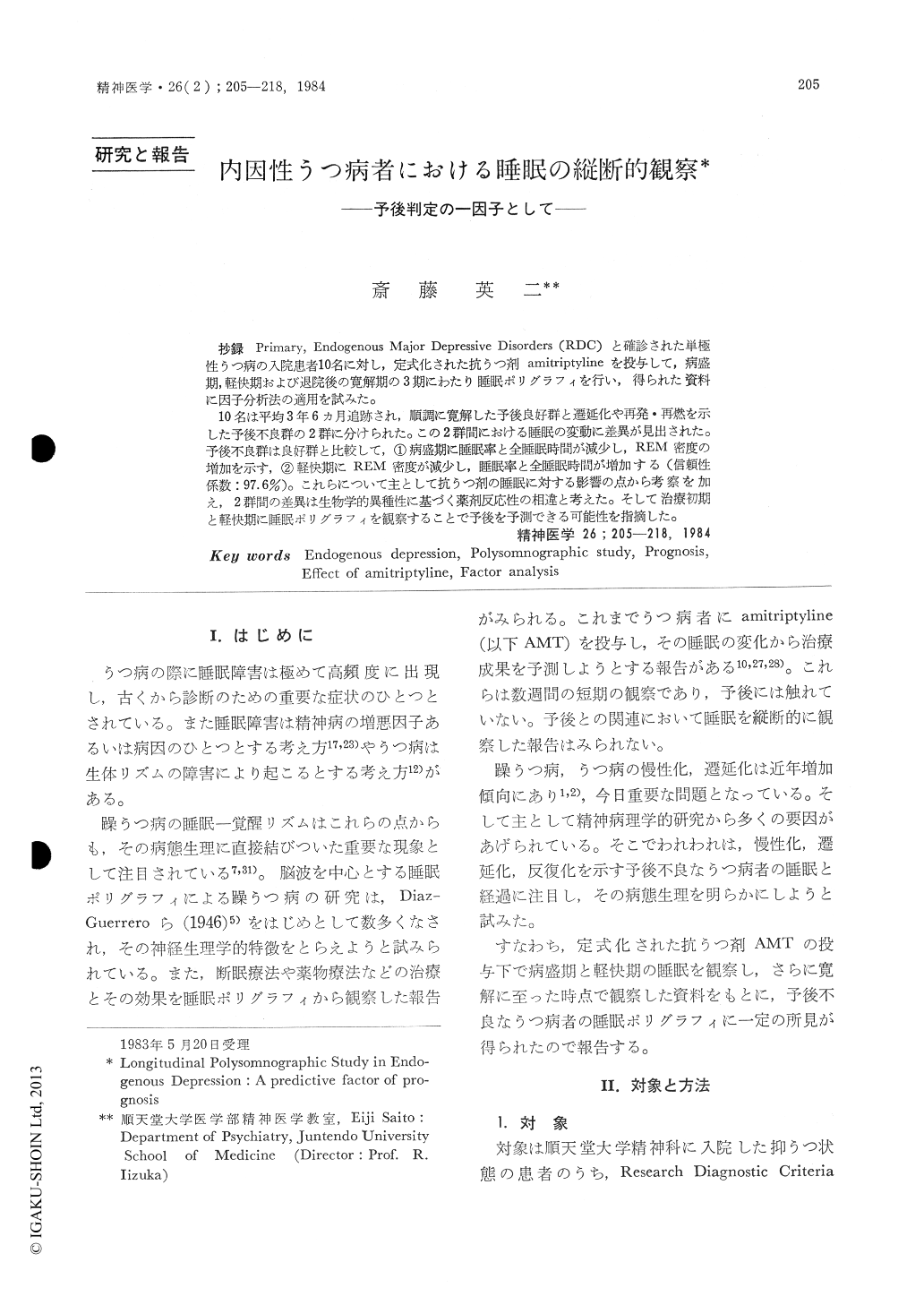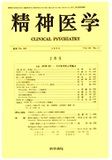Japanese
English
- 有料閲覧
- Abstract 文献概要
- 1ページ目 Look Inside
抄録 Primary,Endogenous Major Depressive Disorders(RDC)と確診された単極性うつ病の入院患者10名に対し,定式化された抗うつ剤amitriptylineを投与して,病盛期,軽快期および退院後の寛解期の3期にわたり睡眠ポリグラフィを行い,得られた資料に因子分析法の適用を試みた。
10名は平均3年6ヵ月追跡され,順調に寛解した予後良好群と遷延化や再発・再燃を示した予後不良群の2群に分けられた。この2群間における睡眠の変動に差異が見出された。予後不良群は良好群と比較して,①病盛期に睡眠率と全睡眠時間が減少し,REM密度の増加を示す,②軽映期にREM密度が減少し,睡眠率と全睡眠時間が増加する(信頼性係数:97.6%)。これらについて主として抗うつ剤の睡眠に対する影響の点から考察を加え,2群間の差異は生物学的異種性に基づく薬剤反応性の相違と考えた。そして治療初期と軽快期に睡眠ポリグラフィを観察することで予後を予測できる可能性を指摘した。
All-night polysomnographic recordings were ob-tained during three phases, i.e. acute, improved and remission phases, on ten in-patients (5 males, 5 females) who had been nosologically defined as Primary Major Depressive Disorder by the Re-search Diagnostic Criteria (RDC). These cases were first onset, unipolar, homogeneous depres-sives and endogenous, 'definite' by RDC. All the patients were given 75mg of amitriptyline at the acute phase and three consecutive nights sleep recordings including one adaptation night were obtained. After that procedure they were treated in an ordinary way. After seen as improved, two con-secutive nights sleep recordings were obtained, for which they were given 30mg of amitriptyline, before they were discharged. The patients were followed up as outpatients and polysomnographic recordings were done at their remission without medication.
The follow-up study was carried out for three and a half years, on average. According to the clinical findings, samples were divided into two groups: the good prognosis group, the patients of which group have come to the full remission without re-lapses; the poor prognosis group, those of which have become chronic, up to subremission at the best, or relapsed afterwards.
From the polysomnographic data of each night, fifteen sleep variables were selected. Using factor analysis it was found that these two groups had different types of sleep disturbances.
The good prognosis group showed a strong sup-pression of REM at the acute phase, while their Sleep Efficiency Index (SEI) and Total Sleep Time (TST) at the acute phase indicated no sig-nificant differences with the remission phase. At the improved phase REM sleep variables of the good prognosis group was considerably improved, and SEI and TST were decreased or unchanged.
By contrast, the poor prognosis group at the acute phase showed decreased SEI and TST and increas-ed REM density. Other REM sleep variables in-dicated disturbance in comparison with those at the remission phase, but specific tendencies were not distinguished. At the improved phase SEI and TST increased and REM density decreased. REM sleep increased somewhat but not so significantly as in the case of the good prognosis group.
Hence the characteristics of the sleep disturbance of the poor prognosis group in comparison with the good prognosis group were as follows: (1) At the acute phase REM density became higher, and SEI and TST became lower than at the remission phase.
(2) At the improved phase REM sleep varia- bles did not indicate sufficient recovery. REM density decreased, while that of the good prognosis group increased.
As these results were investigated in the view of the effect of a tricyclic antidepressant upon sleep which suppresses REM sleep and has sedative effect, it can be concluded that members of thegood prognosis group are good responders to tricyclic antidepressant, and that members of the poor prognosis group are poor-or non-responders to it. The fact that a few samples of this study did not respond to any kind of treatment with antidepressants clinically and became chronic would be a good example of the hypothesis. There were some subjects, however, who responded to treatment and improved for a while, then relapsed and did not recover to complete remission even after admission to the hospital.
Quite a few psychopathological studies of de-pression with poor prognosis have pointed out vari-ous psycho-social factors, which were not conclu-sive by any means. We suggest that an evaluation of polysomnograph as a biological index can be a significant way of predicting the prognosis of depres-sion.

Copyright © 1984, Igaku-Shoin Ltd. All rights reserved.


